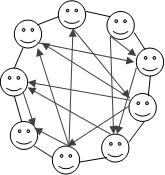
Valuing Volunteering: Philippines researcher Jody Aked asks, what have we learned about volunteer combinations?
Rings of reciprocity
Before this project I knew one of the current limitations for assessing the wider impact of effort exerted through volunteering was an academic literature focused on the individual volunteer. I thought this may have just been a short-coming in the scholarship of volunteering but I have found that much of volunteering policy and practice follows suit. Volunteers are compartmentalised as discrete units in a bigger effort or strategy. It can be seen in the way we fund and organise volunteering for development, primarily via different volunteer platforms – e.g., international, youth, national, diaspora etc – or type – e.g, NGO, academic, church-based. When it comes to proving our worth to funders we try to create a picture of overall impact by adding up all the individual efforts of the actors we categorise as volunteers.
Ways of giving
One of the problems with this way of expressing impact is that volunteers rarely, if ever, work on their own. The social value they create happens in relation with the efforts of others. With the Valuing Volunteering project our inquiry to understand the when, how and the why starts with everyday experiences. What I have noticed is that the change coming from volunteering cannot be wholly explained by mutual self-help or ‘pay it forward’ models.
Social network mapping of youth volunteers shows that their successes come about through acts of giving bound together by a sequence of social actions and interactions. When it works well, it may look something a bit like the Ring of Reciprocity. When it works less well the structure will show clear ring-masters holding the expertise and ring-leaders acting as the main link connecting everyone else.
Here are some examples of how volunteer acts reverberate round the wider system.
In the Philippines we have seen how the positive energy associated with doing something for the public good can create subtle but significant ripple effects in a social context. Young people tell me the experience of working with volunteers has encouraged them to think beyond the household to work for wider community well-being, even when this means going against parent’s wishes. This civic mindedness is a step change which could make a big difference in a generation’s time.
We have seen ideas travel as well as attitudes. A local volunteer and I have just finished documenting how a volunteer-created health sanitation day moved from one municipality to a neighbouring one after a Regional Health Supervisor saw what he liked and ran it locally eight months later. He showed us the pictures he took at the original event and then showed us more recent photos of the activities in his locality, talking us through the hand-washing and seminars on dengue he kept and the one on defecation and toilet use he added to suit the local context. How did he come to know about the event in the first place? The volunteers invited him to speak in one of their sessions.
In other cases we have seen people sort of fall into volunteering. We have started to call this sort of response ‘pop-up’ volunteering. It is the moment a local person becomes involved in a volunteer-led initiative because of the relationship they have with a volunteer. As they see a project is important to someone they have grown to care about, by social extension it becomes important to them. My favourite pop-up volunteers are trusted habal-habal (motorbike) drivers. From helping set up events to jumping into school sessions to help translate, these guys have contributed important roles in the change effort.
It makes me wonder why we exert more effort matching volunteers to specific tasks than we do to teams or locally embedded networks. In the world of paid work good recruiters look at building a team with a wide range of strengths. HR do not only think about skills but also about personality fit, values, how to complement existing expertise with incoming experience. Coaxing performance is about how to manage the talent of each individual while also maintaining a good group dynamic.
I have seen volunteer efforts beyond the funded volunteer placement go unnoticed and clumsily under-appreciated. Opportunities are missed to capture and build on the change potential that comes from ‘first followers’ or the ‘pop-up volunteers’. These moments could be the first steps towards a more local active citizenry, for example. But we don’t know because we don’t typically track who volunteers connect with and what their connections go on to think, feel and do as a result.
All this is telling me that the sector needs to think a lot more about combinations. I am not just referring to combinations of volunteers. I am talking about local multi-stakeholder teams comprising local community members, authorities, NGOs and volunteers. A team focus means organising volunteering by change effort, and not by volunteering platform. This aligns sector practice more closely with the realities of how volunteers work. It also creates many more possibilities for integrating a role for volunteers into existing development programs to strengthen their impact. It is on this issue that we need to begin exploring our insights about the specific value of adding volunteers into development processes with funders.
Sources
Grant, Adam. (2013). Give and Take: A Revolutionary Approach to Success. New York: Viking Adult
http://www.humaxnetworks.com/tryonthering.asp










Add new comment